Research on Sustainable Development Model of Chinese Artist Village
Abstract
1. Introduction
2. Literature Review
3. Collection of Research Sample Data and Data Acquisition
3.1. Basic Conditions of Research Samples
3.2. General Condition of Field Investigation Samples
4. Development Path of Artist Village in China and Problems
4.1. Guangzhou Xiaozhou Artist Village
4.2. Chongqing Gujianshan Artist Village
4.3. Beijing Songzhuang Artist Village
4.4. Discussion
5. Construction of a Sustainable Development Model of Artist Villages in China
5.1. 3T Principle
5.2. Sustainable Development Modes of Artist Villages in China
5.2.1. Initiation Stage
5.2.2. Development Stage
5.2.3. Maturity Stage
6. Conclusions and Future
Author Contributions
Funding
Data Availability Statement
Acknowledgments
Conflicts of Interest
References
- Zhao, Q.; Jia, F.; Chen, L.; Li, Y. A survival for freedom and art- A dialogue on living status of artists in artist villages. Artist 2003, 10, 43–45. [Google Scholar]
- Zhang, Z. Primary investigation on cultural creative industrial development in rural areas in China. East China Econ. Manag. 2013, 2, 62–67. [Google Scholar]
- Zheng, N. The social space of contemporary art. In Annual Collection of Chinese Art Critics; Li, X., Ed.; Shanghai University Press: Shanghai, China, 2018. [Google Scholar]
- Sun, C.; Wu, X. Howe artist village in China become a real creation cradle of artists. Entrep Daily, 7 March 2018. [Google Scholar]
- Li, W.; Wang, H. Creative industry promotes transformation of economic growth modes—Mechanism, mode and path. China Ind. Econ. 2006, 11, 5–11. [Google Scholar]
- Ren, X.F. Artistic Urbanization: Creative Industries and Creative Control in Beijing. Int. J. Urban Reg. Res. 2012, 5, 504–521. [Google Scholar] [CrossRef]
- Qian, J.X.; He, S.J.; Liu, L. Aestheticisation, rent-seeking, and rural gentrification amidst China’s rapid urbanisation: The case of Xiaozhou village, Guangzhou. J. Rural Stud. 2013, 10, 331–345. [Google Scholar] [CrossRef]
- Crawshaw, J.; Gkartzios, M. Getting to know the island: Artistic experiments in rural community development. J. Rural Stud. 2016, 43, 134–144. [Google Scholar] [CrossRef]
- Wang, Y. Previous and present conditions of Shangyuan Artist Village. Collect. Invest. Guide 2015, 13, 62–65. [Google Scholar]
- Ju, Y. “I’m going home!”—Art promotes renaissance of villages and “Xu Village Plan”. Archit. J. 2013, 12, 22–26. [Google Scholar]
- Yang, W. Experiencing rise and fall of Songzhuang Village. Skyline 2017, 1, 188–194. [Google Scholar]
- Kong, J. Research on development of original art agglomeration in Beijing Songzhuang Village. Soc. Sci. Beijing 2008, 2, 21–26. [Google Scholar]
- Li, X. Mode of Artist Gathering in Songzhuang. Beijing Plan. Constr. 2005, 5, 104. [Google Scholar]
- Lin, L. Construction of a special town in the background of new urbanization. Urban Constr. Theor. Study 2018, 8, 21–28. [Google Scholar]
- Ma, X. Seeking the falling artist village. Obs. Think. 2006, 7, 46–49. [Google Scholar]
- Liu, Q.; Liao, J.; Zhang, Y. The disappeared “Village of Writers”. Guangzhou Daily, 18 September 2009. [Google Scholar]
- Xie, Q. Three Art Streets of Shengzhuang, 791 and City Town of Nanchang Are Going to Disappear. Jiangxi Morning Post, 7 December 2016. [Google Scholar]
- Liu, Y.; Liu, D. The Straw of Crushed Steel Transport Real Estate- “Jinfoshan Artist Village” is on Auction at the Price of 35.22 Millions of RMB. Chongqing Commercial Daily, 11 October 2016. [Google Scholar]
- Sun, Z. Changes of Artist Villages in China in the Previous 10 Years: Where is the Gospel of Avant-Garde Artists? China Culture Daily, 6 December 2010. [Google Scholar]
- Florida, R. The Rise of the Creative Class; Basic Books: New York, NY, USA, 2002. [Google Scholar]
- Scott, A.J. The cultural Economy of Cities; Sage Publications: London, UK, 2000. [Google Scholar]
- Hall, P. Creative cities and economic development. Urban Stud. 2000, 37, 639–649. [Google Scholar] [CrossRef]
- Gainza, X. Culture-led neighbourhood transformations beyond the revitalisation/gentrification dichotomy. Urban Stud. 2017, 54, 953–970. [Google Scholar] [CrossRef]
- Sklair, L. The Icon Project: Architecture, Cities and Capitalist Globalization; Oxford University Press: New York, NY, USA, 2017. [Google Scholar]
- Jeff, C.; Francesco, S. Historic Cities: Issues in Urban Conservation; The Getty Conservation Institute: Los Angeles, CA, USA, 2019. [Google Scholar]
- Camerin, F. Contemporary European City-Making Process: Materialization-Emptying-Regeneration on Large Land Propertie. In European Planning History in the 20th Century; Guerra, M.W., Abarkan, A., María, A., Romón, C., Pekár, M., Eds.; Routledge: New York, NY, USA, 2022; pp. 175–185. [Google Scholar]
- Sergio, L.P. A Glossary of Urban Voids; JOVIS Verlag: Berlin, Germany, 2020. [Google Scholar]
- Gao, Y. Top-Down and Bottom-Up Processes for Rural Development and the Role of Architects in Yunnan, China. Buildings 2016, 12, 47. [Google Scholar] [CrossRef]
- Bischoff, A. Exploring cultural roots & planting seeds for growth: Cultural development through design. In Proceedings of the 1st WSEAS International Conference on Landscape Architecture, Algarve, Portugal, 11–13 June 2008; Panagopoulos, T., Burley, J.B., Eds.; pp. 104–110. [Google Scholar]
- Nishimura, E.; Shambroom, H.; Silva, S. Navigating the Creative Processes for the Arts and the Third Cultural Space: A Comparative Analysis of Two International Artist Residency Programs. Int. J. Soc. Political Community Agendas Arts 2017, 12, 37–57. [Google Scholar] [CrossRef]
- Joaquim, R. Why Artists Cluster in Big Cities? Infrastructural Factors of Location, Professional Strategies and Community Dynamics. Rev. Española De Investig. Sociol. 2014, 147, 73–86. [Google Scholar]
- Villar-Argáiz, P. The “unfettered freedom” of “flitting bats”: The Inoperative Community in James Joyce’s A Portrait of the Artist as a Young Man. James Joyce Q. 2015, 52, 531–556. [Google Scholar] [CrossRef]
- Jenkins, L.D.; Romanos, M. The art of tourism-driven development: Economic and artistic well-being of artists in three Balinese communities. J. Tour. Cult. Chang. 2014, 4, 293–306. [Google Scholar] [CrossRef]
- Zhang, X. Research on Artist Village and Folks in City Areas; Wuhan University: Wuhan, China, 2013. [Google Scholar]
- Zeng, J. Development of China from the perspective of industrial cluster. Art Educ. Study 2014, 1, 66–67. [Google Scholar]
- Liu, X.; Han, S.S. Art villages in metropolitan Beijing: A study of the location dynamics. Habitat Int. 2013, 10, 176–183. [Google Scholar] [CrossRef]
- Han, S. An Empirical Sutdy on the Factors of Citizen Participation for Gamcheon cultural village Regeneration. J. Local Gov. Stud. 2014, 26, 113–134. [Google Scholar]
- Park, S.H. The Comparison of Artists’ Creating Networks at Artists’ Villages: Focusing on Munrae Artists’Village and Totatoga. J. Korean Urban Manag. Assoc. 2012, 25, 181–200. [Google Scholar]
- Hu, H. The Chinese Way of Cultural Industry Development; Social Science Literature Press: Beijing, China, 2018. [Google Scholar]
- Liu, J.; Chen, H.; Li, W. Comparative Study on Chinese and Western Cultural Industries; China Social Sciences Press: Beijing, China, 2013. [Google Scholar]
- Zamagni, A.; Pesonen, L.; Swarr, T. From LCA to Life Cycle Sustainability Assessment: Concept, practice and future directions. Int. J. Life Cycle Assess. 2013, 18, 1637–1641. [Google Scholar] [CrossRef]
- Sun, Y. Community Life Cycle and Community Business Development Law. Shanghai Bus. 2003, 3, 10–12. [Google Scholar]
- Yuan, R. Discussion on Art Groups in Guangzhou Xiaozhou Artist Village. Panor. Chin. Natl. 2016, 5, 44–45. [Google Scholar]
- Huang, N. Research on the Current Situation and Strategy of the Development of Chongqing’s Rural Cultural and Creative Industries under the Background of New Urbanization. Master’s Thesis, Chongqing Normal University, Chongqing, China, 2016. [Google Scholar]
- Li, X. Pattern of Songzhuang Artists Gathering Area. Beijing Plan. Constr. 2005, 5, 104–105. [Google Scholar]
- Kong, J. Songzhuang: The largest original art district in China—The development research of Songzhuang original art cluster in Beijing. Art Invest. 2007, 3, 29–30. [Google Scholar]
- Wang, H. A glimpse of the ecology of Beijing Art District. Art Mark. 2015, 17, 51–55. [Google Scholar]
- Cheng, M. Path Options for Urban Creative Industry Based on 3T Theory. Econ. Probl. 2010, 4, 55–57. [Google Scholar]
- Li, W. Research on the Development Path of Creative Industries Abroad Based on “3T” Theory. Product. Res. 2013, 3, 156–157. [Google Scholar]
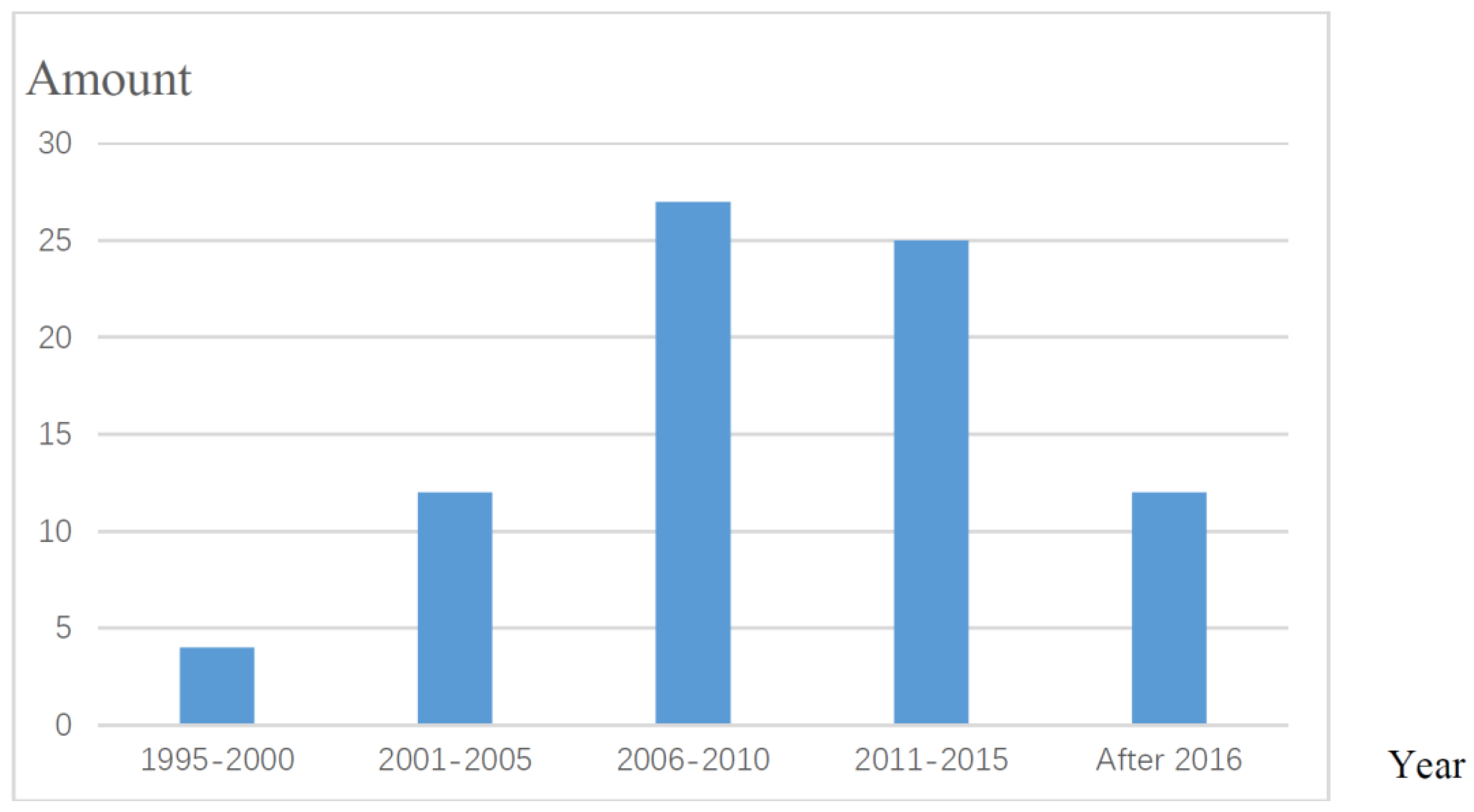
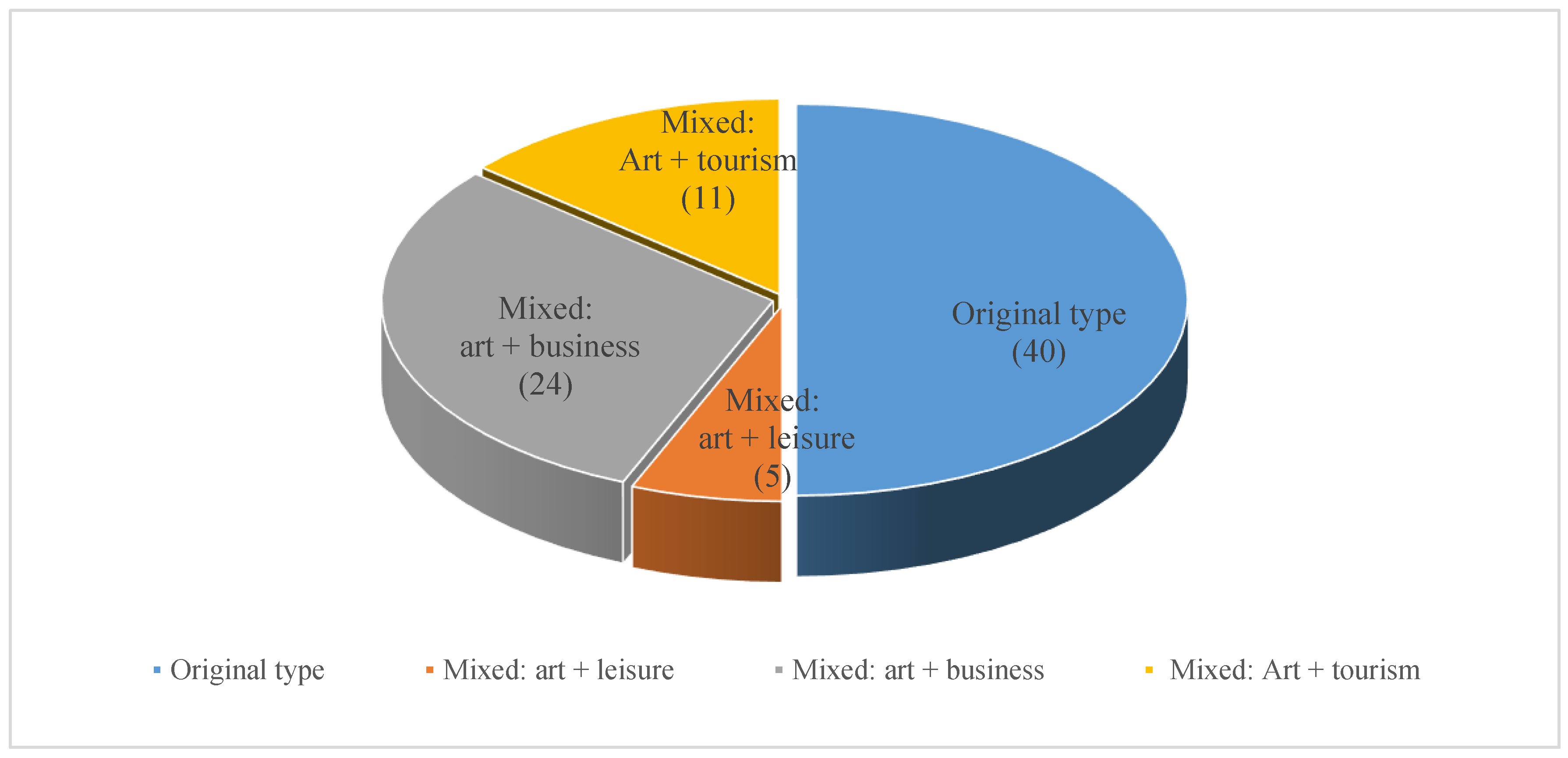
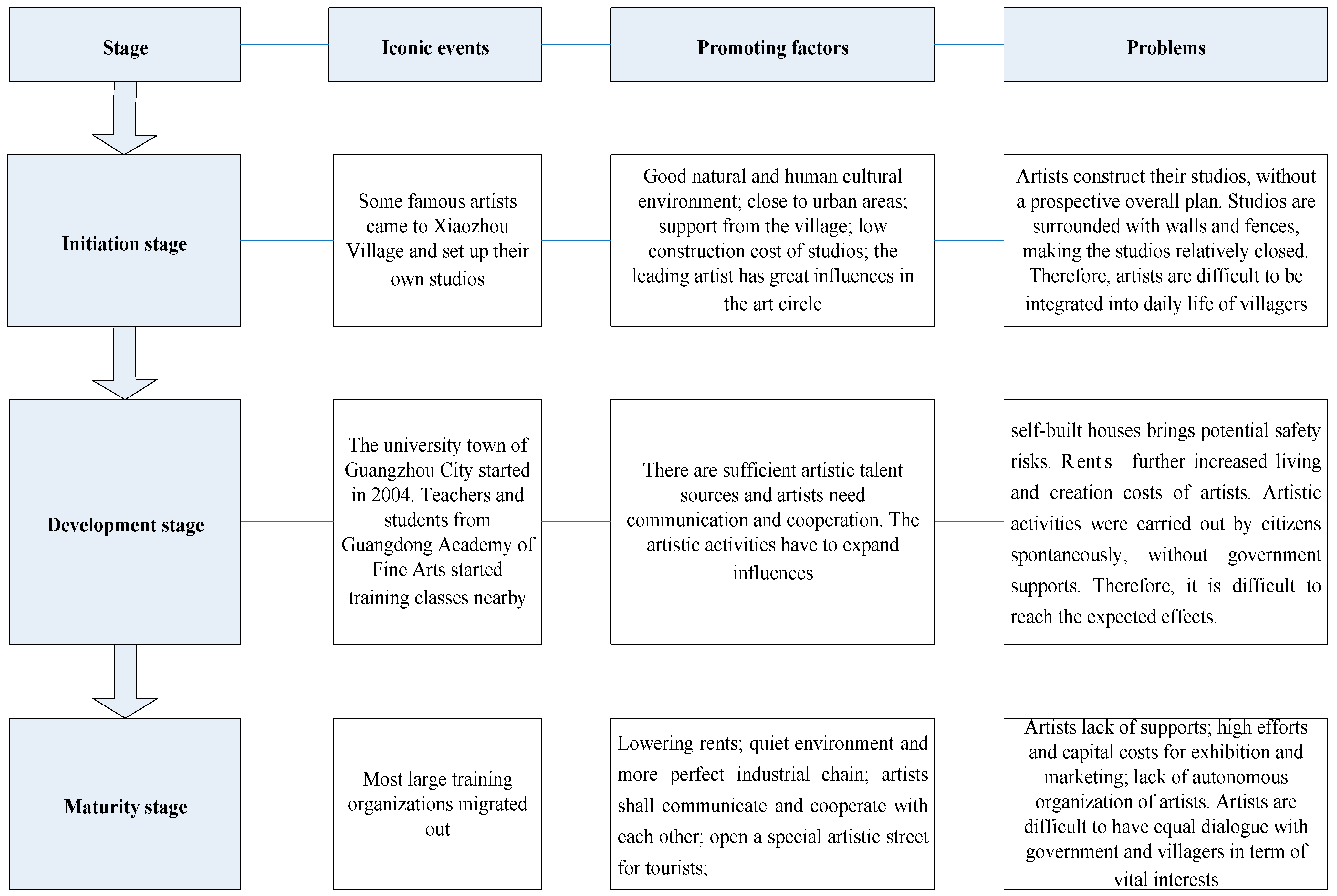
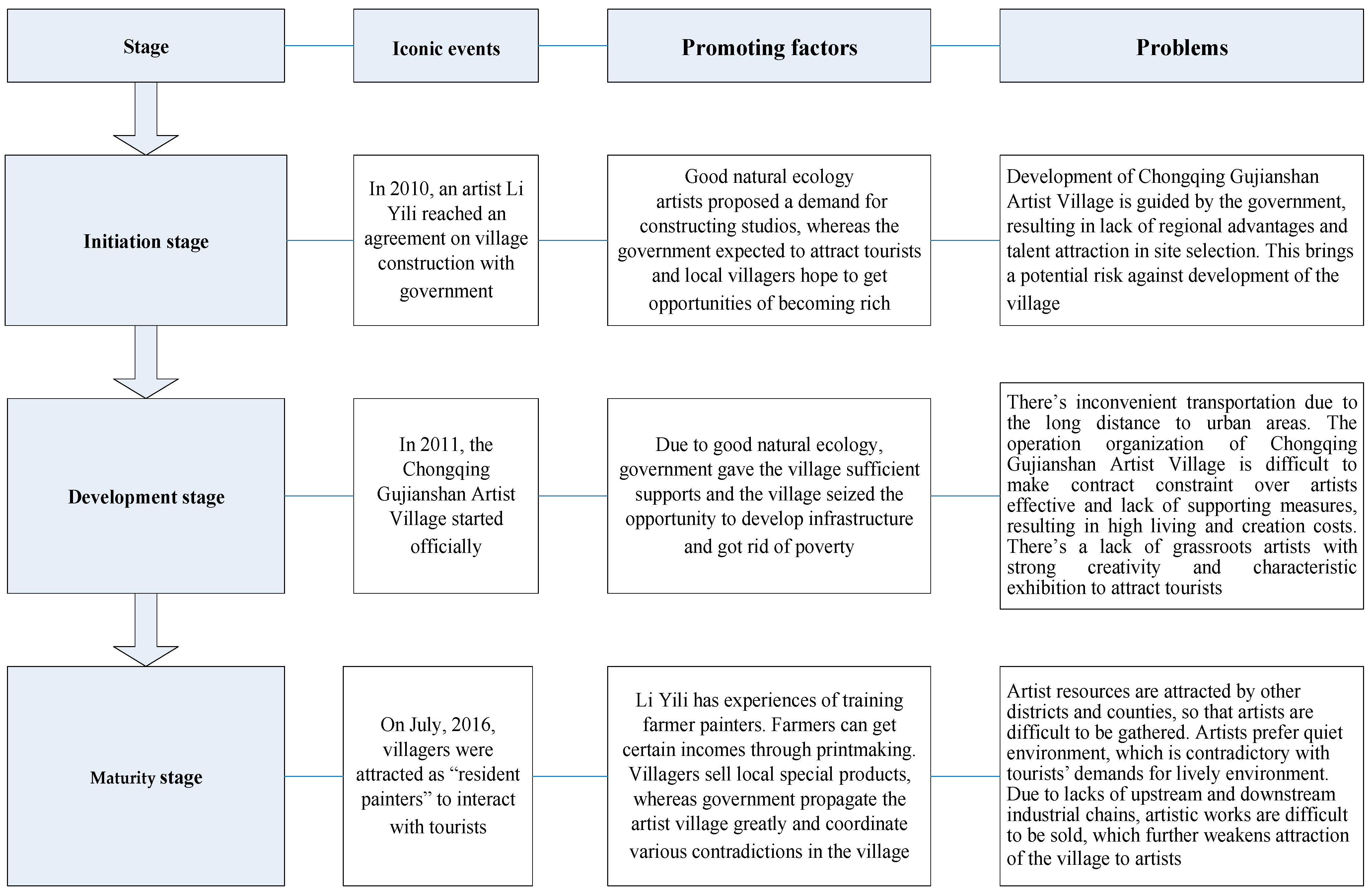

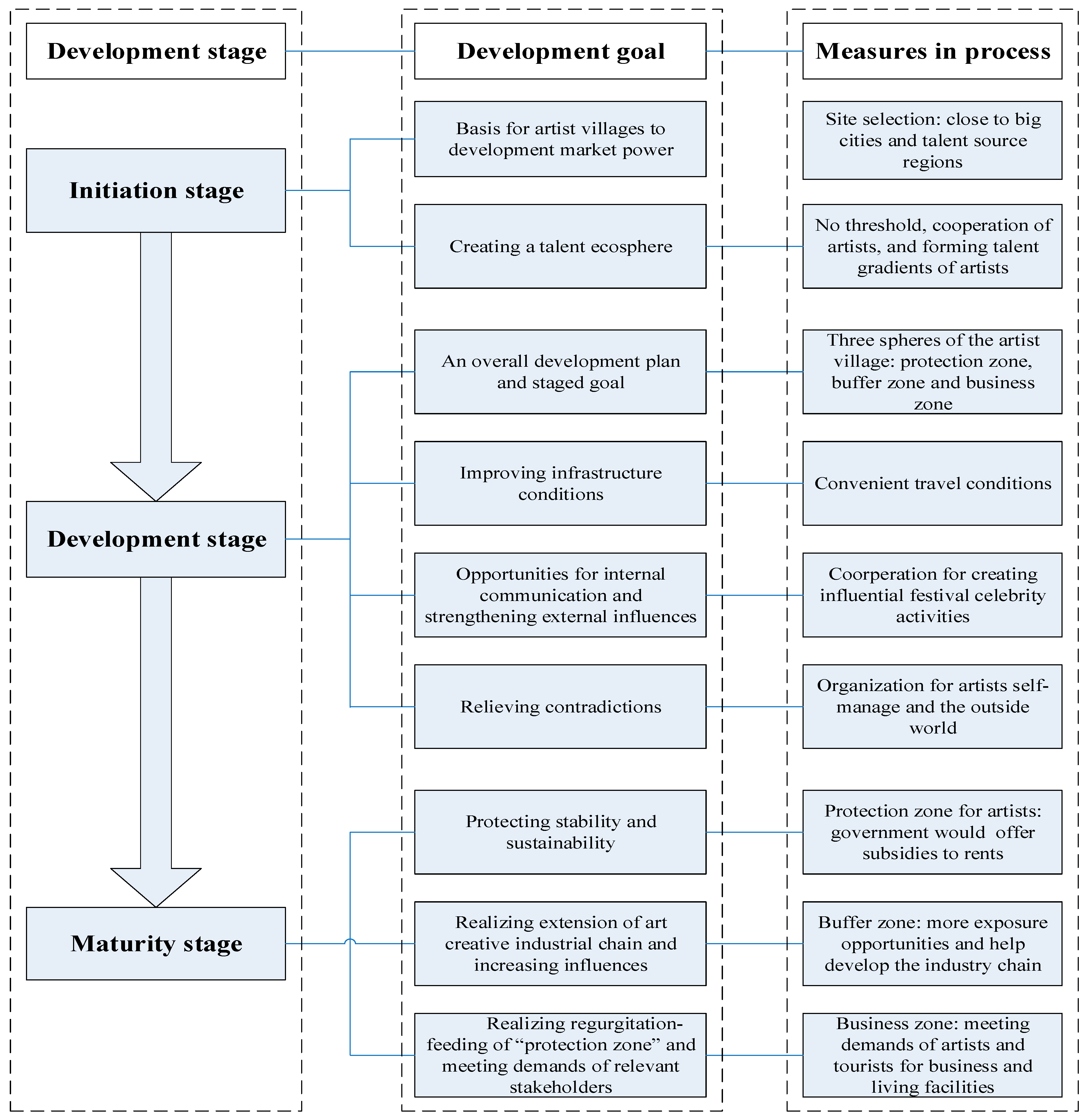
| Places | Number | Percentage |
|---|---|---|
| Anhui | 4 | 5.0% |
| Beijing | 20 | 25.0% |
| Guangdong | 6 | 7.5% |
| Guangxi | 7 | 8.8% |
| Guizhou | 3 | 3.8% |
| Hunan | 1 | 1.3% |
| Jiangsu | 2 | 2.5% |
| Jiangsu | 6 | 7.5% |
| Shaanxi | 1 | 1.3% |
| Shanghai | 1 | 1.3% |
| Sichuan | 9 | 11.3% |
| Yunnan | 10 | 12.5% |
| Chongqing | 10 | 12.5% |
| No. | Name of Artist Village | Date of Initiation | Property | Region | Location | General Conditions |
|---|---|---|---|---|---|---|
| Case 1 | Guangzhou Xiaozhou Artist Village | 1992 | Mixed type, art + business | Coastal developed regions | Ancient village in near suburbs | Decreasing from the original 200–300 artists to more than 100 at present |
| Case 2 | Beijing Songzhuang Artist Village | 1994 | Original | Coastal developed regions | Ancient village in near suburbs | The number of artists is 4000–6000. |
| Case 3 | Chongqing Ciqikou Artist Village | 1999 | Mixed, art + business | Middle and west China | Ancient town in urban area | Decreasing the dozens of artists to 2 at present. |
| Case 4 | 798 Art District | 2002 | Original | Coastal developed regions | Waste factories in cities | Decreasing 30–40 artists to less than 10 at present. |
| Case 5 | Chengdu Landing Artist Village | 2003 | Original | Middle and west China | Rural areas in near suburbs | More than 500 artists |
| Case 6 | Chongqing Gujianshan Artist Village | 2010 | Original, art + tourism | Middle and west China | Rural areas in far suburbs | More than 20 artists |
| Case 7 | Hefei Cuigang Artist Village | 2013 | Mixed, art + business | Middle and west China | Rural areas in near suburbs | More than 30 artists |
| Case 8 | Shenzhen Fenghua Ancient Village | 2014 | Mixed, art + tourism | Coastal developed regions | Ancient village in near suburbs | Chinese National Academy of Arts settled down. |
| Development Model | Typical Representatives | Development Status | Development Factors |
|---|---|---|---|
| Market-dominated development | Guangzhou Xiaozhou Artist Village, 798 Art District and Chongqing Ciqikou Artist Village | These Artist Villages developed quickly, but artists are easy to be squeezed out by capitals. | There are stable artistic talent sources, market activity and good market connection. |
| Government-dominated development | Chongqing Gujianshan Artist Village and Shenzhen Fenghua Ancient Village | Slow development | With government supports, these Artist Villages are easy to get financial and infrastructure supports. |
| Market + government-dominated development | Beijing Songzhuang Artist Village, Chengdu Landing Artist Village and Hefei Cuigang Artist Village | Quick development with supports from the government | In early stage, artists develop independently. After getting government supports, activity of market elements is stimulated and Artist Village enters into prosperity. |
Disclaimer/Publisher’s Note: The statements, opinions and data contained in all publications are solely those of the individual author(s) and contributor(s) and not of MDPI and/or the editor(s). MDPI and/or the editor(s) disclaim responsibility for any injury to people or property resulting from any ideas, methods, instructions or products referred to in the content. |
© 2023 by the authors. Licensee MDPI, Basel, Switzerland. This article is an open access article distributed under the terms and conditions of the Creative Commons Attribution (CC BY) license (https://creativecommons.org/licenses/by/4.0/).
Share and Cite
Luo, Y.; Xiang, P.; Li, B. Research on Sustainable Development Model of Chinese Artist Village. Buildings 2023, 13, 164. https://doi.org/10.3390/buildings13010164
Luo Y, Xiang P, Li B. Research on Sustainable Development Model of Chinese Artist Village. Buildings. 2023; 13(1):164. https://doi.org/10.3390/buildings13010164
Chicago/Turabian StyleLuo, Yun, Pengcheng Xiang, and Bo Li. 2023. "Research on Sustainable Development Model of Chinese Artist Village" Buildings 13, no. 1: 164. https://doi.org/10.3390/buildings13010164
APA StyleLuo, Y., Xiang, P., & Li, B. (2023). Research on Sustainable Development Model of Chinese Artist Village. Buildings, 13(1), 164. https://doi.org/10.3390/buildings13010164












